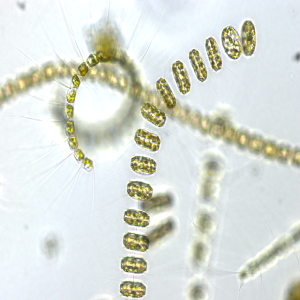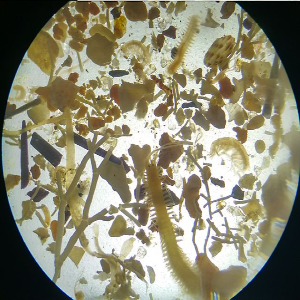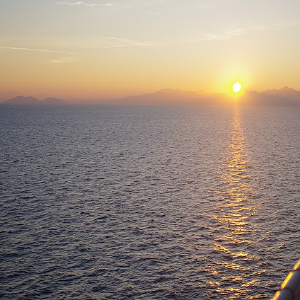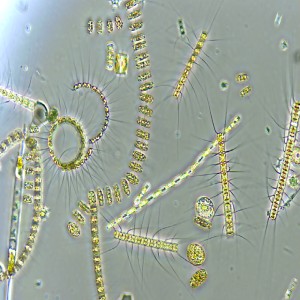Biology, ecology and management perspectives of overexploited deposit-feeders sea cucumbers, with focus on Holothuria tubulosa (Gmelin, 1788)
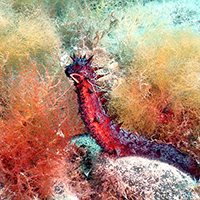
Accepted: 12 October 2021
HTML: 45
All claims expressed in this article are solely those of the authors and do not necessarily represent those of their affiliated organizations, or those of the publisher, the editors and the reviewers. Any product that may be evaluated in this article or claim that may be made by its manufacturer is not guaranteed or endorsed by the publisher.
The increasing harvesting of low trophic level organisms is rising concern about the possible consequences on the ecosystem functioning. In particular, the continuous demand of sea cucumbers from the international market lead to the overexploitation of either traditionally harvested and new target species, including the Mediterranean ones. Sea cucumbers are mostly deposit feeders able to consume sedimentary organic matter and, thus, are ideal candidate for the remediation of eutrophicated sediments, like those beneath aquaculture plants. Breeding and restocking of overexploited sea cucumbers populations are well established practice for Indo-Pacific species like Holothuria scabra and Apostichopus japonicus. Some attempts have been also made for the Mediterranean species Holothuria tubulosa, but, so far, the adaptation of protocols used for other species presented several issues. We here summarize narratively the available information about sea cucumbers rearing protocols with the aim of identifying their major flaws and gaps of knowledge and fostering research about new triggers for spawning and feasible protocols to reduce the high mortality of post-settlers.
Agudo N, 2006. Sandfish hatchery techniques. Australian Centre for International Agricultural Research, Secretariat of the Pacific Community and WorldFish Center. Noumea, New Caledonia: 45 pp.
Amaro T, Bianchelli S, Billett DSM, Cunha MR, Pusceddu A, Danovaro R, 2010. The trophic biology of the holothurian Molpadia musculus: implications for organic matter cycling and ecosystem functioning in a deep submarine canyon. Biogeosciences 7:2419-2432.
Anderson SC, Flemming JM, Watson R, Lotze HK, 2011a. Rapid global expansion of invertebrate fisheries: trends, drivers, and ecosystem effects. PLoS One 6:1-9.
Anderson SC, Flemming JM, Watson R, Lotze HK, 2011b. Serial exploitation of global sea cucumber fisheries. Fish Fish. 12:317-339.
Anderson SC, Lotze HK, Shackell NL, 2008. Evaluating the knowledge base for expanding low trophic-level fisheries in Atlantic Canada. Can. J. Fish. Aquat. Sci. 65:2553-2571.
Andrew NL, Agatsuma Y, Ballesteros E, Bazhin AG, Creaser EP, Barnes DKA, Botsford LW, Bradbury A, Campbell A, Dixon D, Einarsson S, Gerring PK, Herbert K, Hunter M, Hur SB, Johnson P K, Juinio-Meñez M A, Kalvass P, Miller RJ, Moreno CA, Palleiro JS, Rivas D, Robinson SM, Schroeter SC, Steneck RS, Vadas RL, Woodby DA, Xiaoqi Z, 2002. Status and management of world sea urchin fisheries. Oceanogr. Mar. Biol. Annu. Rev. 40:343-425.
Angel DL, Eden N, Breitstein S, Yurman A, Katz T, Spanier E, 2002. In situ bio-filtration: a means to limit the dispersal of effluents from marine finfish cage aquaculture. Hydrobiologia 469:1-10.
Antoniadou C, Vafidis D, 2011. Population structure of the traditionally exploited holothurian Holothuria tubulosa in the south Aegean Sea. Cah. Biol. Mar. 52:171-175.
Battaglene SC, Bell JD, 2004. The restocking of sea cucumbers in the Pacific Islands. In: Bartley DM and Leber, KL (eds.), Case studies in marine ranching. FAO Fisheries Technical Paper 429:109-132.
Battaglene SC, Seymour EJ, Ramofafia C, 1999. Survival and growth of cultured juvenile sea cucumbers, Holothuria scabra. Aquaculture 178:293-322.
Berkes F, Hughes TP, Steneck RS, Wilson JA, Bellwood DR, Crona B, Folke C, Gundersson LH, Leslie HM, Norberg J, Nyström M, Olsson P, Österblom H, Sheffer M, Worm B, 2006. Globalization, roving bandits, and marine resources. Science 311:1557-1558.
Bordbar S, Anwar F, Saari N, 2011. High-value components and bioactives from sea cucumbers for functional food - a review. Mar. Drugs. 9:1761-1805.
Bulteel P, Jangoux M, Coulon P, 1992. Biometry, bathymetric distribution, and reproductive cycle of the holothuroid Holothuria tubulosa (Echinodermata) from Mediterranean Sea grass beds. Mar. Ecol. 13:53-62.
Burford MA, Thompson PJ, McIntosh RP, Bauman RH, Pearson DC, 2003. Nutrient and microbial dynamics in high-intensity, zero-exchange shrimp ponds in Belize. Aquaculture 219:393-411.
Çakly S, Cadun A, Kisla D, Diçer T, 2004. Determination of quality characteristics of Holothuria tubulosa (Gmelin 1788) in Turkish sea (Aegean region) depending on sun drying process step used in Turkey. Int. J. Food Sci. Tech. 13:3-16.
Choo PS, 2008. Population status, fisheries and trade of sea cucumbers in Asia, p. 81-118. In: V. Toral-Granda, A. Lovatelli and M. Vasconcellos (eds.), Sea cucumbers. A global review of fisheries and trade. No. 516. Rome, Italy.
Conand C, 2006. Sea cucumber biology, taxonomy, distribution and conservation status, p.33-50. In A.W. Bruckner (ed.), Proceedings of the CITES workshop on the conservation of sea cucumbers in the families Holothuriidae and Stichopodidae. NOAA Technical Memorandum NMFSOPR 34. Silver Spring, USA.
Conand C, Polidoro B, Mercier A, Gamboa R, Hamel JF, Purcell S, 2014. The IUCN Red List assessment of aspidochirotid sea cucumbers and its implications. SPC Beche-de-mer Inf. Bull. 34:3-7.
Costa V, Mazzola A, Vizzini S, 2014. Holothuria tubulosa Gmelin 1791 (Holothuroidea, Echinodermata) enhances organic matter recycling in Posidonia oceanica meadows. J. Exp. Mar. Bio. Ecol. 461:226-232.
Coulon P, Jangoux M, 1993. Feeding rate and sediment reworking by the holothuroid Holothuria tubulosa (Echinodermata) in a Mediterranean seagrass bed off Ischia Island, Italy. Mar. Ecol. Prog. Ser. 92:201-204.
Couvray S, Miard T, Bunet R, Martin Y, Grillasca J-P, Bonnefont J-L, Coupé S, 2015. Experimental release of Paracentrotus lividus sea urchin juveniles in exploited sites along the French Mediterranean coast. J. Shellfish Res. 34:1-9.
Dance SK, Lane I, Bell JD, 2003. Variation in short-term survival of cultured sandfish (Holothuria scabra) released in mangrove-seagrass and coral reef flat habitats in Solomon Islands. Aquaculture 220:495-505.
Dar MA, Ahmad HO, 2006. The feeding selectivity and ecological role of shallow water holothurians in the Red Sea. SPC Beche-de-mer Inf. Bull. 24:11-21.
David CPC, Maria YY, Siringan FP, Reotita JM, Zamora PB, Villanoy CL, Sombrito EZ, Azanza RV, 2009. Coastal pollution due to increasing nutrient flux in aquaculture sites. Environ. Geol. 58:447-454.
Dawbin WH. 1949. Auto-evisceration and the regeneration of the viscera in the holothurian Stichopus mollis (Hutton). Trans. R. Soc. N.Z. 77:497-523.
Dereli H, Culha ST, Culha M, Ozalp BH, Tekinay AA, 2015. Reproduction and population structure of the sea cucumber Holothuria tubulosa in the Dardanelles Strait, Turkey. Med. Mar. Sci. 17: 47-55.
Despalatović M, Grubelić I, Šimunović A, Antolić B, Žuljević A, 2004. Reproductive biology of the holothurian Holothuria tubulosa (Echinodermata) in the Adriatic Sea. J. Mar. Biol. Assoc. UK. 84:409-414.
Dolmatov IY, 2014. Asexual Reproduction in Holothurians. Sci. World J. 2014:527234.
Dolmatov IY, 2021. Molecular aspects of regeneration mechanisms in holothurians. Genes (Basel). 12:1-31.
Dolmatov IY, Ginanova TT, 2009. Post-autotomy regeneration of respiratory trees in the holothurian Apostichopus japonicus (Holothuroidea, Aspidochirotida). Cell. Tissue. Res. 336:41-58.
Domínguez-Godino JA, González-Wangüemert M, 2018. Breeding and larval development of Holothuria mammata, a new target species for aquaculture. Aquac. Res. 49:1430-1440.
Domínguez-Godino JA, Slater MJ, Hannon C, González-Wangüermert M, 2015. A new species for sea cucumber ranching and aquaculture: breeding and rearing of Holothuria arguinensis. Aquaculture 438:122-128.
Duy NDQ, Francis DS, Southgate PC, 2016. Development of hyaline spheres in late auriculariae of sandfish, Holothuria scabra: is it a reliable indicator of subsequent performance? Aquaculture 465:144-151.
Eaves AA, Richard Palmer A, 2003. Widespread cloning in echinoderm larvae. Nature 425:146.
FAO, 2008. The state of world fisheries and aquaculture. Technical report, Food and Agriculture Organization of the United Nations, Rome, Italy: 196 pp.
FAO, 2012. Report on the FAO workshop on sea cucumber fisheries: an ecosystem approach to management in the Pacific (SCEAM Pacific). Food and Agriculture Organization of the United Nations. Report. No. 1003. Rome, Italy: 44 pp.
FAO, 2020. The State of world fisheries and aquaculture. Sustainability in action. Food and Agriculture Organization of the United Nations. Rome, Italy: 224 pp.
Fodelianakis S, Papageorgiou N, Karakassis I, Ladoukakis ED, 2015. Community structure changes in sediment bacterial communities along an organic enrichment gradient associated with fish farming. Ann. Microbiol. 65:331-338.
Fredalina BD, Ridzwan BH, Abidin Z, Kaswandi M, Zaiton H, Zali I, Kittakoop P, Jais MM, 1999. Fatty acid compositions in local sea cucumber, Stichopus chloronotus, for wound healing. Gen. Pharmacol. 33:337-340.
García-Arrarás JE, Schenk C, Rodrigues-Ramirez R, Torres II, Valentin G, Candelaria AG, 2006. Spherulocytes in the echinoderm Holothuria glaberrima and their involvement in intestinal regeneration. Dev. Dyn. 235:3259-3267.
Giglioli AA, Addis P, Pasquini V, Secci M, Hannon C, 2021. First assessment of restocking efficacy of the depleted sea urchin Paracentrotus lividus populations in two contrasted sites. Aquac. Res. 00:1-5.
Glockner-Fagetti A, Calderon-Aguilera LE, Herrero-Pérezrul MD, 2016. Density decrease in an exploited population of brown sea cucumber Isostichopus fuscus in a biosphere reserve from the Baja California peninsula, Mexico. Ocean Coast. Manag. 121:49-59.
González-Wangüemert M, Aydin M, Conand C, 2014. Assessment of sea cucumber populations from the Aegean Sea (Turkey): first insights to sustainable management of new fisheries. Ocean Coast. Manag. 92:87-94.
González-Wangüemert M, Domínguez-Godino JA, Cánovas F, 2018. The fast development of sea cucumber fisheries in the Mediterranean and NE Atlantic waters: from a new marine resource to its over-exploitation. Ocean Coast. Manag. 151:165-177.
González-Wangüemert M, Valente S, Aydin M, 2015. Effects of fishery protection on biometry and genetic structure of two target sea cucumber species from the Mediterranean Sea. Hydrobiologia 743:65-74.
Granada L, Sousa N, Lopes S, Lemos MFL, 2015. Is integrated multitrophic aquaculture the solution to the sectors' major challenges? - a review. Rev. Aquacult. 8:283-300.
Gustato G, Villari A, Del Gaudio S, Pedata P, 1982. [Ulteriori dati sulla distribuzione di Holothuria tubulosa, Holothuria polii e Holothuria stellati nel Golfo di Napoli.].[Article in Italian]. Boll. Soc. Nat. Napoli 91:1-14.
Hamel JJF, Mercier A, 2008. Population status, fisheries and trade of sea cucumbers in temperate areas of the Northern Hemisphere, p.257-291. In V. Toral-Granda, A. Lovatelli and M. Vasconcellos (eds.), Sea cucumbers. A global review of fisheries and trade. FAO Fisheries and Aquaculture Technical Paper. No. 516. Rome, Italy.
Hammond LS, 1983. Nutrition of deposit-feeding holothuroids and echinoids (Echinodermata) from a shallow reef lagoon, Discovery Bay, Jamaica. Mar. Ecol. Prog. Ser. 10:297-305.
Hartati R, Zainuri M, Ambariyanto A, Widianingsih W, 2020. Feeding selectivity of Holothuria atra in different microhabitat in Panjang Island, Jepara (Java, Indonesia). Biodiversitas 21:2233-2239.
Herrero-Perezrul D, Reyes-Bonilla H, Garcia-Dominguez F, Cintra-Buenrostro CE, 1999. Reproduction and growth of Isostichopus fuscus in the southern gulf of California, Mexico. Mar. Biol. 135:521-532.
Holmer M, Argyrou M, Dalsgaard T, Danovaro R, Diaz-Almela E, Duarte CM, Frederiksen M, Grau A, Karakassis I, Marba N, Mirto S, Perez M 2008. Effects of fish farm waste on Posidonia oceanica meadows: synthesis and provision of monitoring and management tools. Mar. Poll. Bull. 56:1618-1629.
Horton T, Kroh A, Ahyong S, Bailly N, Boyko CB, Brandão SN, et al. (2018) World Register of Marine Species (WoRMS).
Israel D, Lupatsch I, Angel DL, 2019. Testing the digestibility of seabream wastes in three candidates for integrated multi-trophic aquaculture: grey mullet, sea urchin and sea cucumber. Aquaculture 510:364-370.
Işgören-Emiroǧlu D, Günay D, 2007. The effect of sea cucumber Holothuria tubulosa (G., 1788) on nutrient and sediment of Aegean Sea shores. Pak J Biol Sci. 10:586-589.
Ito S, Kitamura H, 1997. Induction of larval metamorphosis in the sea cucumber Stichopus japonicus by periphitic diatoms. Hydrobiologica 358:281-284.
Jumars PA, 2000. Animal guts as non-ideal chemical reactors: partial mixing and axial variation in absorption kinetics. Am. Nat. 155:544-555.
Karakassis I, 2000. Impact of cage farming of fish on the seabed in three Mediterranean coastal areas. ICES J. Mar. Sci. 57:1462-1471.
Keeley NB, Macleod CK, Hopkins GA, Forrest BM, 2014. Spatial and temporal dynamics in macrobenthos during recovery from salmon farm induced organic enrichment: when is recovery complete? Mar. Pollut. Bull. 80:250-262.
Kim T, Yoon HS, Shin S, Oh MH, Kwon I, Lee J, Choi SD, Jeong KS, 2015. Physical and biological evaluation of co-culture cage systems for grow-out of juvenile abalone, Haliotis discus hannai, with juvenile sea cucumber, Apostichopus japonicus (Selenka), with CFD analysis and indoor seawater tanks. Aquaculture 447:86-101.
Kinch J, Purcell S, Uthicke S, Friederich K, 2008. Population status, fisheries and trade of sea cucumbers in the Western Central Pacific, p.7-55. In: Toral-Granda, M.V., Lovatelli, A., Vasconcellos, M. (eds.), Sea cucumbers: a global review of fisheries and trade, FAO Fisheries and Aquaculture Technical Paper. No. 516. Rome, Italy.
Koukouras A, Sinis AI, Bobori D, Kazantzidis S, Kitsos MS, 2007. The echinoderm (Deuterostomia) fauna of the Aegean Sea, and comparison with those of the neighbouring seas. J. Biol. Res. 7:67-92.
Lamprianidou F, Telfer T, Ross LG, 2015. A model for optimization of the productivity and bioremediation efficiency of marine integrated multitrophic aquaculture. Estuar. Coast. Shelf Sci. 164:253-264.
La Rosa T, Mirto S, Mazzola A, Danovaro R, 2001. Differential responses of benthic microbes and meiofauna to fish-farm disturbance in coastal sediments. Env. Poll. 112:427-434.
Lee S, Ford AM, Mangubhai S, Wild C, Ferse SCA, 2018. Effects of sandfish (Holothuria scabra) removal on shallow-water sediments in Fiji. PeerJ. 6:e4773.
Leiva G, Castilla J, 2002. A review of the world marine gastropod fishery: evolution of catches, management and the Chilean experience. Rev. Fish. Biol. Fish. 11:283-300.
Levinton, JS, 1972. Stability and trophic structure in deposit-feeding and suspension-feeding communities. Am. Nat. 106:472-486.
Lohrer AM, Thrush SF, Gibbs MM, 2004. Bioturbators enhance ecosystem function through complex biogeochemical interactions. Nature 431:1092-1095.
MacDonald CLE, Stead SM, Slater MJ, 2013. Consumption and remediation of European seabass (Dicentrarchus labrax) waste by the sea cucumber Holothuria forskali. Aquac. Int. 21:1279-1290.
MacTavish T, Stenton-Dozey J, Vopel K, Savage C, 2012. Deposit-feeding sea cucumbers enhance mineralization and nutrient cycling in organically enriched coastal sediments. PLoS One 7:50031.
Mangion P, Taddei D, Conand C, Frouin P, 2004. Feeding rate and impact of sediment reworking by two deposit feeders Holothuria leucospilota and Holothuria atra on fringing reef (Reunion Island, Indian Ocean), p.311-317. In: T. Heinzeller and J. H. Nebelsick (eds.), Echinoderms: München, Taylor and Francis, London, UK.
Manini E, Luna G, 2003. Influence of the mineralogic composition on microbial activities in marine sediments: an experimental approach. Chem. Ecol. 19:399-410.
Mathieu-Resuge M, Le Grand F, Schaal G, Kraffe E, Lorrain A, Letourneur Y, Lemonnier H, Benoît, J, Hochard S, 2020. Assimilation of shrimp farm sediment by Holothuria scabra: a coupled fatty acid and stable isotope approach. Aquat. Living Resour. 33:1-12.
Mercier A, Battaglene SC, Hamel JF, 2000. Settlement preferences and early migration of the tropical sea cucumber Holothuria scabra. J. Exp. Mar. Bio. Ecol. 249:89-110.
Mercier A, Hamel JF, 2009. Endogenous and exogenous control of gametogenesis and spawning in Echinoderms. Adv. Mar. Biol. 55:1-302.
Meysman FJR, Galaktionov OS, Gribsholt B, Middelburg JJ, 2006a. Bioirrigation in permeable sediments: advective pore-water transport induced by burrow ventilation. Limnol. Oceanogr. 51:142-156.
Meysman FJR, Middelburg JJ, Heip CHR, 2006b. Bioturbation: a fresh look at Darwin’s last idea. Trend. Ecol. Evol. 21:688–695.
Mezali K, Thandar AS, 2014. First record of Holothuria (Roweothuria) arguinensis (echinodermata: holothuroidea: aspidochirotida: holothuriidae) from the Algerian coastal waters. Mar. Biol. 7:40.
Michio K, Kengo K, Yasunori K, Hitoshi M, Takayuki Y, Hideaki Y, Hiroshi S. 2003. Effects of deposit feeder Stichopus japonicus on algal bloom and organic matter contents of bottom sediments of the enclosed sea. Mar. Pollut. Bull. 47:118-125.
Mirto S, La Rosa T, Gambi C, Danovaro R. Mazzola A, 2002. Nematode community response to fish-farm impact in the wester Mediterranean. Environ. Pollut. 116:203-214.
Mohsen M, Yang H, 2021. Chapter 4 - Sea cucumbers research in the Mediterranean and the Red Seas, p.61-101. In: M. Mohsen, H. Yang (eds.), Sea cucumbers aquaculture, biology and ecology, Academic Press.
Moriarty DJW, 1982. Feeding of Holothuria atra and Stichopus chloronotus on bacteria, organic carbon and organic nitrogen in sediments of the Great Barrier Reef. Mar. Freshw. Res. 33:255-263.
Murray G, García-Arrarás JE, 2004. Myogenesis during holothurian intestinal regeneration. Cell. Tissue Res. 318:515-524.
Navarro, PG, García-Sanz S, Barrio JM, Tuya F, 2013. Feeding and movement patterns of the sea cucumber Holothuria sanctori. Mar. Biol. 160:2957-2966.
Neofitou N, Lolas A, Ballios I, Skordas K, Tziantziou L, Vafidis D, 2019. Contribution of sea cucumber Holothuria tubulosa on organic load reduction from fish farming operation. Aquaculture 501:97-103.
Ocaña A, Sanchez Tocino, L, 2005. Spawning of Holothuria tubulosa (Holothurioidea, Echinodermata) in the Alboran Sea (Mediterranean Sea). Zoologica Baetica 16:147-150.
Pauly D, Christensen V, Guénette S, Pitcher TJ, Sumaila U R, Walters CJ, Watson R, and Zeller D, 2002. Towards sustainability in world fisheries. Nature. 418:689-695.
Penry DL, Jumars PA, 1986. Chemical reactor analysis and optimal digestion. Bioscience 36:310-315.
Penry DL, Jumars, PA, 1987. Modelling animals’ guts as chemical reactors. Am. Nat. 129:69-96
Peters-Didier J, Sewell MA, 2019. The role of the hyaline spheres in sea cucumber metamorphosis: lipid storage via transport cells in the blastocoel. EvoDevo. 10:1-12.
Pietrak M, Kim J, Redmond S, Kim Y, Yarish C, Bricknell I, 2014. Culture of sea cucumber in Korea: a guide to Korean methods and the local sea cucumber in the Northeast U.S. Maine Sea Grant College Program. Orono, USA: 12 pp.
Plagányi ÉE, Skewes T, Murphy N, Pascual R, Fischer M, 2015. Crop rotations in the sea: increasing returns and reducing risk of collapse in sea cucumber fisheries. Proc. Natl. Acad. Sci. U. S. A. 112:6760-6765.
Purcell S, 2004a. Criteria for release strategies and evaluating the restocking of sea cucumbers. In: Lovatelli, A., Conand, C., Purcell, S.W., Uthicke, S., Hamel, J.-F., Mercier, A. (eds.), Advances in sea cucumber aquaculture and management. FAO, Dalian, China: 439 pp.
Purcell S, 2004b. Rapid growth and bioturbation activity of the sea cucumber Holothuria scabra in earthen ponds. Proc. Australasian Aqua. 1:244.
Purcell S, Simutoga M, 2008. Spatio-temporal and size-dependent variation in the success of releasing cultured sea cucumbers in the wild. Rev. Fis. Sci. 16:204-214.
Purcell SW, 2014. Value, market preferences and trade of beche-de-mer from Pacific Island sea cucumbers. PLoS One. 9:95075.
Purcell SW, Conand C, Uthicke S, Byrne M, 2016. Ecological roles of exploited sea cucumbers. Oceanogr. Mar. Biol. Annu. Rev. 54:367–386.
Purcell SW, Hair CA, Mills DJ 2012. Sea cucumber culture, farming and sea ranching in the tropics: progress, problems and opportunities. Aquaculture 368-369:68-81.
Purcell SW, Kirby DS, 2006. Restocking the sea cucumber Holothuria scabra: sizing no-take zones through individual-based movement modelling. Fish. Res. 80:53-61.
Purcell SW, Mercier A, Conand S, Hamel JF, Toral- Granda MV, Lovatelly A, Uthicke S, 2011. Sea cucumber fisheries: global analysis of stocks, management measures and drivers of overfishing. Fish Fish. 14:34-59.
Purwati P, Dwiono SAP, 2005. Fission inducement in Indonesian holothurians. SPC Beche-de-mer Inf. Bull. 22:11-13.
Purwati P, Dwiono, SAP, 2007. Experiment on fission stimulation of Holothuria atra (Holothuroidea, Echinodemata): changing in body weight and morphology. Mar. Res. Indonesia. 32:1-6.
Pusceddu A, Fraschetti S, Mirto S, Holmer M, Danovaro R, 2007. Effects of intensive mariculture on sediment biochemistry. Ecol. Appl. 17:1366-1378.
Rakaj A, Fianchini A, Boncagni P, Lovatelli A, Scardi M, Cataudella S, 2018. Spawning and rearing of Holothuria tubulosa: a new candidate for aquaculture in the Mediterranean region. Aquacult. Res. 49:557-568.
Rakaj A, Fianchini A, Boncagni P, Scardi M, Cataudella S, 2019. Artificial reproduction of Holothuria polii: a new candidate for aquaculture. Aquaculture 498:444-453.
Rakaj A, Morroni L, Grosso L, Fianchini A, Pensa D, 2021. Towards sea cucumbers as a new model in embryo-larval bioassays: Holothuria tubulosa as test species for the assessment of marine pollution. Sci. Total Environ. 787:147593.
Ram R, Chand RV, Southgate PC, 2014. Effects of processing methods on the value of bêche-de-mer from the Fiji Islands. J. Mar. Sci. Res. Dev. 4:1-7.
Ramírez-González J, Moity N, Andrade-Vera S, Mackliff HR, 2020. Estimation of age and growth and mortality parameters of the sea cucumber Isostichopus fuscus (Ludwig, 1875) and implications for the management of its fishery in the Galapagos Marine Reserve. Aquac. Fish. 5:245-252.
Ramón M, Simarro G, Galimany E, Lleonart J, 2019. Evaluation of sediment particle size selection during feeding by the holothurian Parastichopus regalis (Cuvier, 1817). Reg. Stud. Mar. Sci. 31:100763.
Reise K 2002. Sediment mediated species interactions in coastal waters. J. Sea Res. 48:127-141.
Reyes-Bonilla H, Herrero-Pérezrul MD, 2003. Population parameters of an exploited population of Isostichopus fuscus (Holothuroidea) in the southern Gulf of California, Mexico. Fish. Res. 59:423-430.
Roberts D, Gebruk AV, Levin V, Manship BAD, 2000. Feeding and digestive strategies in deposit-feeding holothurians. Oceanogr. Mar. Biol. Ann. Rev. 38:257-310.
Roberts D, Moore HM, Berges J, Patching JW, Carton MW, Eardly DF, 2001. Sediment distribution, hydrolytic enzyme profiles and bacterial activities in the guts of Oneirophanta mutabilis, Psychropotes longicauda and Pseudostichopus villosus: what do they tell us about digestive strategies of abyssal holothurians? Prog. Oceanogr. 50:443-458.
Romero-Gallardo S, Velázquez-Abunader, López-Rocha JA, Garza-Gisholt E, 2018. Natural mortality estimates throughout the life history of the sea cucumber Isostichopus badionotus (Holothuroidea: Aspidochirotida). PeerJ. 6:5235.
Schneider K, Silverman J, Kravitz B, Rivlin T, Schneider-Mor A, Barbosa S, Byrne M, Caldeira K, 2013. Inorganic carbon turnover caused by digestion of carbonate sands and metabolic activity of holothurians. Estuar. Coast. Shelf Sci. 133:217-223.
Shiell G, 2004. Field observations of juvenile sea cucumbers. SPC Beche-De-Mer Inf. Bull. 20:11.
Shpigel M, Shauli L, Odintsov V, Ben-Ezra D, Neori A, Guttman L, 2018. The sea urchin, Paracentrotus lividus, in an integrated multi-trophic aquaculture (IMTA) system with fish (Sparus aurata) and seaweed (Ulva lactuca): nitrogen partitioning and proportional configuration. Aquaculture 490:260-269.
Sicuro B, Levine J, 2011. Sea cucumber in the Mediterranean: a potential species for aquaculture in the Mediterranean. Rev. Fish. Sci. 19:299-304.
Skewes T, Dennis D, Burridge CM, 2000. Survey of Holothuria scabra (sandfish) on Warrior Reef, Torres Strait. CISRO Division of Marine Research. Queensland, Australia: 28 pp.
Slater MJ, Carton AG, 2007. Survivorship and growth of the sea cucumber Australostichopus (Stichopus) mollis (Hutton 1872) in polyculture trials with green-lipped mussel farms. Aquaculture 207:389-398.
Slater MJ, Carton AG, 2009. Effect of sea cucumber (Australostichopus mollis) grazing on coastal sediments impacted by mussel farm deposition. Mar. Pollut. Bull. 58:1123-1129.
Slater MJ, Jeffs AG, Carton AG, 2009. The use of the waste from green-lipped mussels as a food source for juvenile sea cucumber, Australostichopus mollis. Aquaculture 292:219-224.
Slater MJ, Jeffs AG, Sewell MA, 2011. Selective movement and deposit-feeding in juvenile sea cucumber, Australostichopus mollis determined in situ and in the laboratory. J. Exp. Mar. Bio. Ecol. 409:315-323.
Smiley S, McEuen FS, Chaffee C, Krishnan S, 1991. Echinodermata: Holothuroidea, p.663-750. In: Giese, A.C., Pearse, J.S., Pearse, V.B. (eds.), Reproduction of marine invertebrates, Echinoderms and Iophophorates, vol. VI. Boxwood Press, Pacific Grove, California, USA.
Solan M, Cardinale BJ, Downing AL, Engelhardt, KAM, Ruesink JL, Srivastava DS, 2004. Extinction and ecosystem function in the marine benthos. Science. 306:1177-1180.
Spirina IS, Dolmatov IY, 2003. Mitotic activity in tissues of the regenerating respiratory tree of the holothurian Apostichopus japonicus (Holothuroidea, Aspidochirota). Russ. J. Mar. Biol. 29:123-125.
Strathmann RR, 1975. Larval feeding in echinoderms. Integr. Comp. Biol. 15:717-730.
Sun J, Zhang L, Pana Y, Lin C, Wang F, Kand R, Yang H. 2015. Feeding behavior and digestive physiology in sea cucumber Apostichopus japonicus. Physiol. Behav. 139:336-343.
Tahri Y, Dermeche S, Chahrour F, Bouderbala M, 2019. The reproduction cycle of the sea cucumber Holothuria (Holothuria) tubulosa Gmelin, 1791 (Echinodermata Holothuroidea Holothuriidae) in Oran coast, Algeria. Biodivers. J. 10:159-172.
Tolon MT, Emiroglu D, Gunay D, Ozgul A, 2017a. Sea cucumber (Holothuria tubulosa Gmelin, 1790) culture under marine fish net cages for potential use in integrated multitrophic aquaculture (IMTA). Indian J. Geo. Mar. Sci. 46:749-756.
Tolon T, Emiroglu D, Gunay D, Hancı B, 2017b. Effect of stocking density on growth performance of juvenile sea cucumber Holothuria tubulosa (Gmelin, 1788). Aquac. Res. 48:4124-4131.
Toral-Granda MV, Martínez PC, 2007. Reproductive biology and population structure of the sea cucumber Isostichopus fuscus (Ludwig, 1875) (Holothuroidea) in Caamaño, Galapagos Islands, Ecuador. Mar. Biodivers. 151:2091-2098.
Toral-Granda V, 2008. Galapagos Islands: a hotspot of sea cucumber fisheries in Central and South America, p.231-253. In V. Toral-Granda, A. Lovatelli and M. Vasconcellos (eds.), Sea cucumbers. A global review of fisheries and trade. FAO Fisheries and Aquaculture Technical Paper. No. 516. Rome, FAO.
Tortonese, E, 1965. Fauna d’Italia, Echinodermata. Ed. Calderini, Bologna, Italia: 419 pp.
Troell M, 2009. Chapter 9. Integrated marine and brackishwater aquaculture in tropical regions: research, implementation and prospects, p.47-131. In D. Soto (ed.), Integrated mariculture: a global review. FAO Fisheries and Aquaculture Technical Paper. No. 529. Rome, FAO.
Uthicke S, 2001. Nutrient regeneration by abundant coral reef holothurians. J. Exp. Mar. Bio. Ecol. 265:153-170.
Uthicke S., Benzie J.A.H. 2000. The effect of bêche-de-mer fishing on densities and size structure of Holothuria nobilis (Echinodermata: Holothuroidea) populations on the Great Barrier Reef. Coral Reefs. 19:271-276.
Uthicke S, Benzie J, Ballment E, 1998. Genetic structure of fissiparous populations of Holothuria (Halodeima) atra on the Great Barrier Reef. Mar. Biol. 132:141-151.
Uthicke S, Benzie J, Ballment E, 1999. Population genetics of the fissiparous holothurian Stichopus chloronotus (Aspidochirotida) on the Great Barrier Reef, Australia. Coral Reefs. 18:123-132.
Uthicke S, Conand C, 2005. Amplified fragment length polymorphism (AFLP) analysis indicates the importance of both asexual and sexual reproduction in the fissiparous holothurian Stichopus chloronotus (Aspidochirotida) in the Indian and Pacific Ocean. Coral Reefs 24:103-111.
Uthicke S, Conand C, Benzie J, 2001. Population genetics of the fissiparous holothurians Stichopus chloronotus and Holothuria atra (Aspidochirotida): a comparison between the Torres Strait and La Réunion. Mar. Biol. 139:257-265.
Uthicke S, Karez R, 1999. Sediment patch selectivity in tropical sea cucumbers (Holothuroidea: Aspidochirotida) analysed with multiple choice experiments. J. Exp. Mar. Biol. Ecol. 236:69-87.
Uthicke S, Purcell S, 2004. Preservation of genetic diversity in restocking of the sea cucumber Holothuria scabra planned through allozyme electrophoresis. Can. J. Fish. Aquat. Sci. 61:519-528.
Wen J, Hu C, Fan S 2010. Chemical composition and nutritional quality of sea cucumbers. J. Sci. Food Agric. 90:2469-2474.
Wilkie IC, 2001. Autotomy as a prelude to regeneration in echinoderms. Microsc. Res. Tech. 55: 369-396.
Yanagisawa T, 1998. Chapter 9. Aspects of the biology and culture of the sea cucumber, p.291-308. In: S. De Silva (ed.), Tropical Mariculture. Academic Press, London, UK.
Yang H, Bai Y, 2015. Chapter 1. Apostichopus japonicus in the life of Chinese people, p.1-24. In: H. Yang , J.F. Hamel, A. Mercier (eds.), The sea cucumber Apostichopus japonicus. history, biology, and aquaculture. Academic Press.
Yang H, Hamel JF, Mercier A, 2015. The sea cucumber Apostichopus japonicus: history, biology and aquaculture. Elsevier, London, UK: 454 pp.
Yuan X, Yang H, Meng L, Wang L, Li Y, 2013. Impacts of temperature on the scavenging efficiency by the deposit-feeding holothurian Apostichopus japonicus on a simulated organic pollutant in the bivalve-macroalage polyculture from the perspective of nutrient budgets. Aquaculture 406-407:97-104.
Yuan X, Yang H, Zhou Y, Mao Y, Zhang T, Liu Y, 2006. The influence of diets containing dried bivalve feces and/or powdered algae on growth and energy distribution in sea cucumber Apostichopus japonicus (Selenka) (Echinodermata: Holothuroidea). Aquaculture 256:457-467.
Zamora LN, Jeffs AG, 2011. Feeding, selection, digestion and absorption of the organic matter from mussel waste by juveniles of the deposit-feeding sea cucumber, Australostichopus mollis. Aquaculture 317:223-228.
Zamora LN, Jeffs AG, 2012a. Feeding, metabolism and growth in response to temperature in juveniles of the Australasian sea cucumber, Australostichopus mollis. Aquaculture 358-359: 92-97.
Zamora LN, Jeffs AG, 2012b. The ability of the deposit-feeding sea cucumber Australostichopus mollis to use natural variation in the biodeposits beneath mussel farms. Aquaculture 326-329:116-122.
Zang Y, Tian X, Dong S, Dong Y, 2012. Growth, metabolism and immune responses to evisceration and the regeneration of viscera in sea cucumber, Apostichopus japonicus. Aquaculture 358-359:50-60.
Zhang X, Sun L, Yuan J, Sun Y, Gao Y, Zhang L, Li S, Dai H, Hamel JF, Liu C, Yu Y, 2017. The sea cucumber genome provides insights into morphological evolution and visceral regeneration. PLoS Biol. 15:2003790.
Zhou Y, Yang H, Liu S, Yuan X, Mao Y, Zhang T, Liu Y, Zhang F, 2006. Feeding on biodeposits of bivalves by the sea cucumber Stichopus japonicus Selenka (Echinodermata: Holothuroidea) and a suspension co-culture of filter-feeding bivalves with deposit feeders in lantern nets from longlines. Aquaculture 256:510-520.
PAGEPress has chosen to apply the Creative Commons Attribution NonCommercial 4.0 International License (CC BY-NC 4.0) to all manuscripts to be published.



 https://doi.org/10.4081/aiol.2021.9995
https://doi.org/10.4081/aiol.2021.9995




